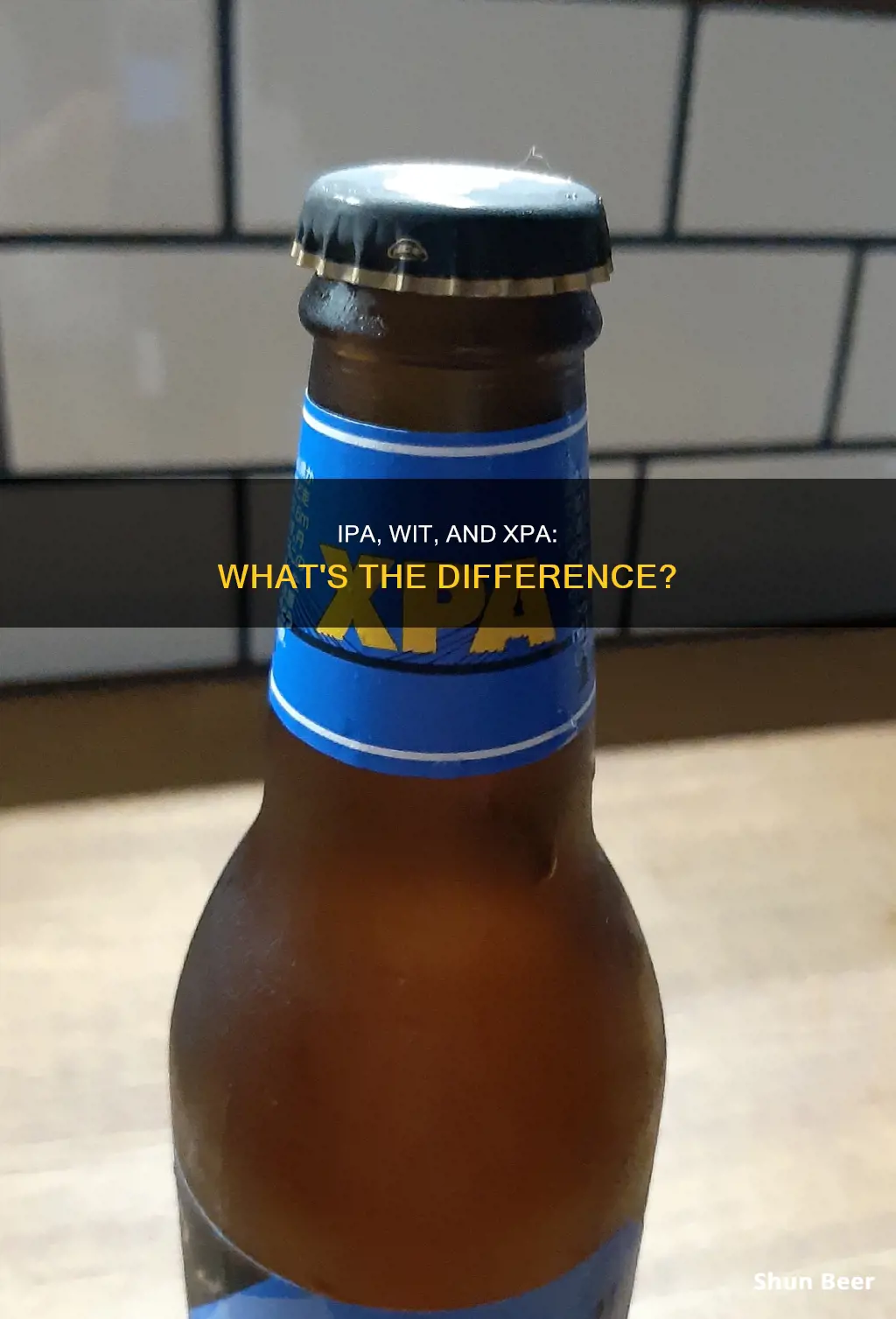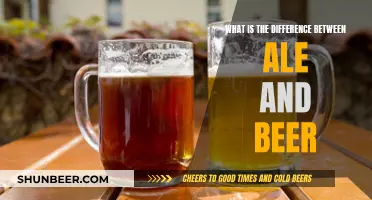
The world of beer is a complex and ever-evolving one, with new styles and variations constantly emerging and blurring the lines between established categories. One such style that has gained prominence in recent years is XPA, or Extra Pale Ale. Sitting somewhere between an American Pale Ale (APA) and an India Pale Ale (IPA), XPA has carved out a unique niche in the beer landscape. This paragraph aims to introduce the topic of the differences between IPA, Wit, and XPA beers, exploring their distinct characteristics and how they cater to diverse consumer preferences and palates.
Differences between IPA, Wit and XPA Beers
| Characteristics | Values |
|---|---|
| IPA | Hop-forward and alcohol-heavy pale ales with higher bitterness and intensity of flavour |
| Wit | N/A |
| XPA | Less bitter and more balanced with lower bitterness, lower hoppiness, and usually lower alcohol content |
What You'll Learn

History of IPA, APA, and XPA beers
The history of IPA, APA, and XPA beers is a long and complex one, with family, geography, and innovation at its heart.
The story begins in the 18th century with the birth of the pale ale, made possible by the development of coke, a clean-burning form of coal that allowed maltsters to create a lighter-coloured malt than the dark, smoky version used previously. This new style of beer was shipped to India and other colonies in casks, but the journey often left the beer degraded and spoiled. To combat this, a hoppier, more alcohol-heavy beer was created to withstand the journey to India, thus resulting in the India Pale Ale, or IPA.
IPAs became popular in England and remained much the same for about two centuries until the emergence of microbreweries in the United States in the 1980s. These brewers began experimenting with American hops, creating a new style of pale ale with vibrant citrus and pine flavours. This marked the birth of the American Pale Ale, or APA. APA beers maintained a balance between malt and hops, with a lighter character and a citrusy punch.
Over time, APAs became increasingly hoppy and higher in alcohol content, leading to the creation of the American-style IPA. This new style of IPA had a cleaner, leaner malt base and used native hops to create a more hop-forward drinking experience.
While the boundaries between these styles of beer were already blurring, the introduction of the XPA, or Extra Pale Ale, in the late 2000s added a new layer of complexity. XPAs emerged in the craft brewing scene in Oregon in 2008 and were later introduced to the Australian market in 2014, quickly gaining popularity. XPAs are often described as a cross between APAs and IPAs, with a strong hop presence and flavourful profile while being lighter in alcohol content.
The "X" in XPA originally stood for "experimental", reflecting the brewers' exploration of new hop varieties, but over time, it came to represent "extra", signifying something extra special or unique about the beer, be it in terms of colour, body, alcohol content, or flavour.
The history of these beer styles is a dynamic one, with family ties, colonial influences, and innovative brewing techniques shaping the evolution of IPA, APA, and XPA beers.
Gulping vs Sipping Beer: Does Drinking Style Affect Taste?
You may want to see also

Characteristics of IPA beers
India Pale Ale (IPA) is a craft beer style characterised by its strong flavour and high bitterness, which comes from its high hops content. The style dates back to British colonial times in India, when brewers would add extra hops to beer to preserve it during the long journey from England to India.
IPA has several major styles, including West Coast IPA, New England IPA, and Imperial/Double IPA. West Coast IPAs tend to be bitter, with piney and citrusy notes. New England IPAs are known for their hazy look and juicy flavour. Double IPAs have a high alcohol content and a big hop flavour.
IPA beers can have a range of flavours, including floral, bitter, earthy, piney, citrusy, and fruity. Some IPAs have a strong citrus taste, while others are fruitier. They are rich in flavour and are known to be the opposite of bland mass-market lagers.
IPA is also dry hopped, which means hops are steeped in the fermenting beer to create a strong aroma that amplifies the fruity and sweet notes of the hops, making them smell better than other types of beer.
Doppelbock vs. Bock Beer: Historical Differences Explained
You may want to see also

Characteristics of APA beers
American Pale Ales (APA) are known for their balance of malts and hops, with a lighter character and a citrusy punch. APA's are less bitter and more balanced than India Pale Ales (IPAs). They have a maltier and more subdued hop character than IPAs, with a cleaner, leaner malt base. APA's typically have an ABV of around 5%, but can range from 4% to 6%.
The hops used in APAs are more assertively pungent and floral than their British counterparts, with citrus-pine American hops being a common feature. The use of American hops in APA's is what separates them from their British family tree. APA's are described as having a "well-rounded, less intense" flavour profile compared to IPAs.
The colour of APA's can vary from pale gold to deep amber, and they may have a wheaty tartness that adds depth to the beer. They often have a gentle, bready malt character, delivering a balanced flavour that is neither too heavy nor too light. APA's may also include trace levels of speciality malt flavour, such as bready, toasty, or biscuity notes.
The "extra" in XPA can refer to a number of things, including extra pale colour, extra light body or alcohol content, or extra hops. XPA's are often lighter in colour, cleaner in fermentation by-products, and have fewer caramel flavours than English pale ales. They tend to be lower in bitterness, hoppiness, and alcohol content than IPAs, and feature fruity hops with citrus and tropical notes.
Anheuser-Busch's Wide World of Beers: How Many Varieties?
You may want to see also

Characteristics of XPA beers
XPA stands for Extra Pale Ale, and these beers are known for their pale colour and light flavour. They are a cross between an American Pale Ale (APA) and an India Pale Ale (IPA), but with a lower alcohol content, typically ranging from 4% to 6% ABV. The exact definition of an XPA is somewhat vague and open to interpretation, with different brewers having their own take on the style. However, there are some common characteristics that define XPA beers.
Firstly, XPAs are characterised by their pale colour, which comes from the use of pale malts. This is in contrast to APAs, which use crystal malts, resulting in a darker gold colour. The lighter colour of XPAs allows the hop flavours to stand out more. XPAs also tend to have a cleaner fermentation process, resulting in fewer caramel flavours than English pale ales.
In terms of taste, XPAs are known for their fruity, citrusy hop flavours with tropical undertones. They are less bitter and more balanced than IPAs, with lower levels of hoppiness and alcohol. The maltiness is less predominant in XPAs, allowing the hops to take centre stage. Some XPAs may also have trace levels of speciality malt flavour, adding a bready, toasty, or biscuity taste.
XPAs are highly sessionable and easy to drink, making them suitable for a range of occasions, from a day at the beach to a night at the pub. They are popular among both beer rookies and craft beer aficionados. The style is particularly well-received in Australia, where it is gaining momentum and picking up awards.
Beer vs. Ale: Supreme Court's Verdict
You may want to see also

How to serve IPA, APA, and XPA beers
Serving India Pale Ale (IPA)
IPAs are best served at a temperature of 45–50°C (5.5-9°C). If you're taking the beer out of a refrigerator, it is recommended to let it sit for five minutes to take off the deep chill. It is also important to use the proper glassware when serving IPAs. An IPA glass is uniquely designed to provide the best aroma and flavour. The rippled base provides agitation with each drink to ensure the hop aromatics are released throughout the drinking experience. The top captures these aromas while also providing a wide opening for easy drinking.
Serving American Pale Ale (APA)
American Pale Ale should be served as soon as it finishes fermenting and drops clear. It is better fresh, but aging doesn't hurt it, only changing it to a less-fruity version. It is a mistake to think of this style as a kind of "scaled-down" American IPA. It's hoppy, but its bittering isn't especially high, especially when compared to its ABV range.
Serving Extra Pale Ale (XPA)
XPA beers are best served at a temperature of 42–48°F (5.5-9°C). The right glassware is crucial for boosting the drinking experience, smell, and taste of the beer. It is also important to use clean glasses to avoid contamination between beers. XPA beers are gaining popularity for their balanced flavour, easy drinkability, and varied options.
Exploring the Diverse Michelob Ultra Beer Family
You may want to see also







